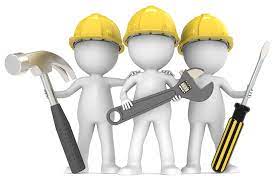Mastering the Art of Regular Maintenance: A Guide to Keeping Things Running Smoothly

The Importance of Regular Maintenance: Keeping Things Running Smoothly
From our cars to our homes, maintenance plays a crucial role in keeping everything functioning optimally. Regular maintenance is like a preventive medicine that helps avoid costly repairs and unexpected breakdowns. It is the key to ensuring that things run smoothly and efficiently for the long term.
Why Maintenance Matters
Maintenance is not just about fixing things when they break; it is about taking proactive steps to prevent issues from occurring in the first place. By regularly servicing and inspecting equipment, vehicles, appliances, and other items, you can identify potential problems early on and address them before they escalate into major issues.
The Benefits of Regular Maintenance
There are numerous benefits to incorporating regular maintenance into your routine:
- Increased Lifespan: Proper maintenance can extend the lifespan of your possessions, saving you money in the long run by delaying the need for replacements.
- Improved Performance: Well-maintained items operate more efficiently, delivering better performance and saving energy.
- Safety: Regular maintenance helps ensure that items are safe to use, reducing the risk of accidents or malfunctions.
- Preserve Value: Maintained items retain their value better than neglected ones, whether it’s a car or a household appliance.
- Piece of Mind: Knowing that your possessions are well-maintained gives you peace of mind and reduces stress related to unexpected breakdowns.
Implementing a Maintenance Schedule
To reap the benefits of maintenance, it’s essential to establish a regular schedule for inspecting and servicing your belongings. This could involve simple tasks like checking oil levels in your car or cleaning filters in household appliances. For more complex systems like heating or cooling units, professional maintenance may be required periodically.
By dedicating time and resources to maintenance now, you can avoid costly repairs and replacements down the line. Remember: prevention is always better than cure!
Common Questions About Maintenance: Definitions, Types, and Usage
- What is the definition of maintenance?
- What describes maintenance?
- What is maintenance and its type?
- Which is correct maintainance or maintenance?
- What do you mean by maintenance?
- What is the meaning of carry out maintenance?
- What is maintenance and its types?
- What is child maintenance used for?
- What is a synonym for maintainment?
- What is maintenance and types of maintenance?
- What is the difference between maintenance and maintainance?
- How is maintenance calculated?
What is the definition of maintenance?
Maintenance can be defined as the process of preserving, servicing, and ensuring the proper functioning of equipment, systems, or items through regular inspections, repairs, and upkeep. It encompasses proactive measures taken to prevent breakdowns and extend the lifespan of possessions by identifying and addressing potential issues before they escalate. Maintenance is essential for keeping things running smoothly, efficiently, and safely over time, ultimately contributing to cost savings and the overall well-being of equipment and users alike.
What describes maintenance?
Maintenance can be described as the proactive and systematic process of preserving, inspecting, and repairing items to ensure their optimal functioning and longevity. It involves regular checks, servicing, and upkeep to prevent potential issues from arising and to address any existing problems promptly. Maintenance is essential for keeping things running smoothly, efficiently, and safely, ultimately extending the lifespan of various possessions and reducing the likelihood of unexpected breakdowns or costly repairs.
What is maintenance and its type?
Maintenance refers to the regular upkeep and care of equipment, systems, or property to ensure their optimal functioning and longevity. There are generally three main types of maintenance: preventive maintenance, which involves scheduled inspections and tasks to prevent breakdowns; predictive maintenance, which uses data and analytics to predict when maintenance is needed; and corrective maintenance, which addresses issues that arise unexpectedly. Each type plays a vital role in keeping things running smoothly and efficiently, ultimately saving time and money in the long run.
Which is correct maintainance or maintenance?
The correct spelling is “maintenance.” It is a common word used to describe the process of keeping something in good condition through regular upkeep and repairs. While “maintainance” may seem like a plausible alternative, it is actually a misspelling. Proper maintenance is essential for the longevity and optimal performance of various items, from vehicles to household appliances, ensuring they function efficiently and safely.
What do you mean by maintenance?
Maintenance refers to the regular upkeep and care of equipment, systems, or items to ensure they remain in optimal working condition. It involves a series of proactive tasks aimed at preventing issues before they arise, as well as addressing any existing problems promptly. Maintenance can encompass various activities such as inspections, cleaning, lubrication, adjustments, and repairs to extend the lifespan and performance of assets. By practising maintenance regularly, individuals and businesses can avoid unexpected breakdowns, enhance efficiency, promote safety, and ultimately save time and money in the long run.
What is the meaning of carry out maintenance?
Carrying out maintenance refers to the process of performing necessary tasks to ensure the proper functioning and longevity of equipment, machinery, or systems. This typically involves inspecting, cleaning, repairing, and replacing components as needed to prevent breakdowns and maintain optimal performance. By regularly carrying out maintenance tasks, individuals or organisations can identify potential issues early on, address them promptly, and ultimately extend the lifespan of their assets while minimising unexpected downtime and costly repairs.
What is maintenance and its types?
Maintenance refers to the regular upkeep and care of equipment, systems, or items to ensure they function optimally and remain in good condition. There are several types of maintenance strategies, each serving a specific purpose. Preventive maintenance involves scheduled inspections and tasks to prevent breakdowns before they occur. Corrective maintenance focuses on fixing issues that have already arisen. Predictive maintenance uses data and analytics to predict when maintenance is needed based on trends and patterns. Lastly, proactive maintenance involves identifying potential problems and taking action to prevent them from occurring. Each type of maintenance plays a crucial role in ensuring the longevity and efficiency of various assets.
What is child maintenance used for?
Child maintenance is financial support provided by one parent to the other for the upbringing of their child. It is intended to cover the costs associated with raising a child, such as food, clothing, education, healthcare, and other essential expenses. Child maintenance ensures that both parents contribute to the financial well-being of their child, regardless of their living arrangements. This support aims to provide a stable and nurturing environment for the child’s growth and development, prioritising their needs and welfare above all else.
What is a synonym for maintainment?
A synonym for “maintainment” is “maintenance.” In the context of upkeep, care, and preservation of something, both terms are used interchangeably to refer to the actions taken to ensure the proper functioning and longevity of equipment, systems, or structures. “Maintenance” encompasses a wide range of activities aimed at sustaining the condition and performance of assets over time, highlighting the importance of regular attention and upkeep to prevent deterioration or breakdowns.
What is maintenance and types of maintenance?
Maintenance refers to the process of preserving, repairing, and ensuring the optimal functioning of various systems, equipment, or assets. There are different types of maintenance strategies that organisations and individuals can implement to keep their possessions in good working condition. These include preventive maintenance, which involves regular inspections and servicing to prevent breakdowns; corrective maintenance, which focuses on fixing issues after they occur; predictive maintenance, which uses data and analytics to anticipate when maintenance is needed; and proactive maintenance, which involves identifying potential problems before they cause disruptions. Each type of maintenance plays a vital role in ensuring the longevity and efficiency of equipment and systems.
What is the difference between maintenance and maintainance?
The common confusion between “maintenance” and “maintainance” often arises due to a simple spelling error. The correct term is “maintenance,” which refers to the process of keeping something in good condition through regular checks, repairs, and servicing. On the other hand, “maintainance” is an incorrect spelling variation that does not have any specific meaning or usage in English language. It is important to use the correct term “maintenance” when discussing the upkeep and care of various items or systems to ensure clarity in communication.
How is maintenance calculated?
Maintenance costs are typically calculated based on various factors such as the type of equipment or property being maintained, the frequency of maintenance activities, the cost of materials and labour involved, and any additional expenses incurred during the maintenance process. Different industries and sectors may have specific formulas or methods for calculating maintenance costs, taking into account factors like depreciation, expected lifespan of assets, and historical data on maintenance expenses. By analysing these key components, businesses and individuals can accurately estimate their maintenance costs and budget effectively to ensure the smooth operation and longevity of their assets.
